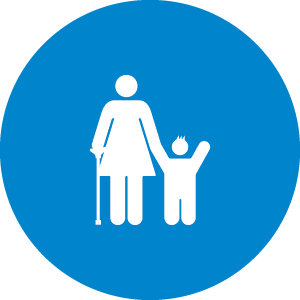
Outdoor Spaces and Buildings
People need public places to gather — indoors and out. Green spaces, safe streets, sidewalks, outdoor seating and accessible buildings can be used and enjoyed by people of all ages.

Transportation
Accessible and affordable transportation options are necessary for active aging. Driving should not be the only way for residents to get where they need to go. Transit options should include public transportation systems (trains and buses) and more targeted taxi services. Volunteers can provide rides to and from a doctor’s office. For those that do drive, parking spaces need to be accessible, widely available, and parking fees and instructions clearly outlined.

Housing
Most people want to remain in their own home and community as they age. Doing so can be possible if housing is designed or modified for aging in place and a community has diverse affordable housing options for varying life stages. Homeowners must be able to adequately maintain and repair their homes in order to stay in them safely.

Social Participation
Social participation and connection are strongly correlated to good health and feelings of well-being throughout life. Participating in social activities in the community, as well as with family, allows people to maintain or establish supportive social networks and social support, which in turn promotes health and well-being.

Respect and Social Inclusion
Feeling respected and included promotes participation and facilitates effective use of programs and services. The extent to which older adults participate in the social, civic and economic life of the city is also closely linked to their experience of inclusion. Intergenerational activities are a great way for people of all ages to learn from one another, honor what each has to offer and, at the same time, feel good about themselves.

Civic Participation & Employment
Work does not need to be an all or nothing experience. Older adults do not stop contributing to their communities in retirement. An age and dementia friendly community provides options for older people to continue to contribute to their communities, through paid employment or voluntary work if they so choose, and to be engaged in the political process.

Communication and Information
Staying connected and getting timely, practical information is vital for people of all ages. Evolving technologies are useful tools but can also act as instruments of social exclusion. An age and dementia friendly community uses multiple streams of media to inform residents about emergencies, resources, services, events, and other local activities.

Community & Business Support
Age and dementia friendly communities include the broad support and involvement from the local community, including local businesses and faith communities. These communities are welcoming and supportive of people of all ages and abilities. Businesses, community agencies, and municipal departments are beginning to understand the impact of aging, dementia, and caregiving on both customers and employees and are trying to respond accordingly.

Healthcare & Continuum of Care
At some point, every person of every age will access the healthcare system. Healthcare services are essential to aging in place. It is important that care be available nearby and essential that residents are able to access and afford the services required. Regarding dementia, it is important that health care systems promote early diagnosis and use dementia care best practices along the continuum of care.

Legal & Advanced Planning
Legal matters can be complex and overwhelming, but planning ahead is key and provides peace of mind to older adults, people living with dementia, and caregivers. Financial security and preparedness are an important component to aging in place and assuring that individual’s wishes are honored as they age and at the end of life.
Adapted from the World Health Organization’s Age-Friendly Initiative and the Dementia Friendly America Initiative.
